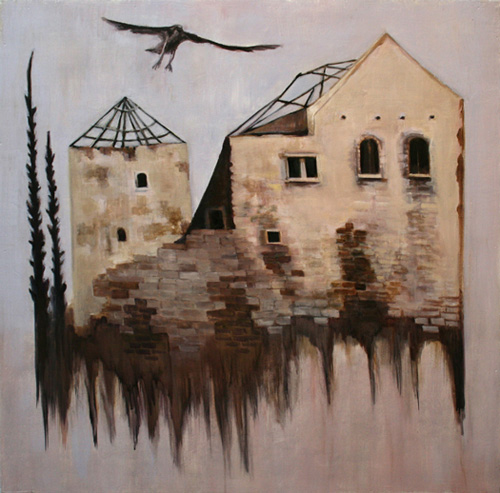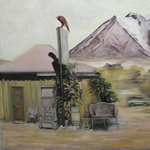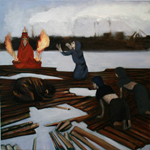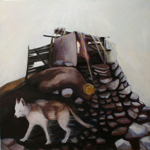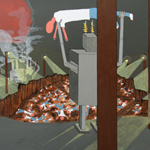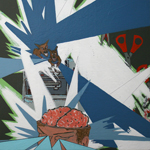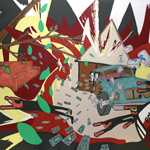
The Time Has Come
Paintings by Tracy Timmins and Billy Kroft
January 12- February 11, 2008
Artist Reception: January 19, 6-9pm
First Friday Reception: February 1, 7-10pm
In their current exhibition The Time Has Come , Oakland artists Tracy Timmins and Billy Kroft explore two separate visions of the fallout of human civilization.
Tracy Timmins shares her vision of a world of post-civilization. Timmins mines imagery from her own personal photographs to combine the concept of consequence and the passage of time, creating a space where nature reparation is allowed to occur, finally winning its war against mankind's existence. Timmins's uses abandoned buildings as stand-ins for the memory of humans, yet highlights their decomposition so the message is not lost: we didn't survive. However, Timmins's doesn't allow her imagery to stop there and infuses a sense of hope by allowing the buildings to be reclaimed by nature, elevating the structures to become part of the landscape. In " Rehabilitation ", Timmins depicts a stone structure whose roof has rotted away, yet the bottom of the structure suggest roots that are seeking their way back to the earth. In " Civil Disobedience ", Timmins portrays a wood structure which echoes a previous life as a family home, but now sits abandoned in the middle of a field with only the surrounding trees and a pack of wild dogs to witness it's decaying existence.
What makes Timmins's painting so intriguing is her ability to depict consequence without the rhetoric of damnation. With these images, Timmins gives the viewer a portal into our possible future, the quiet after the storm. What is subtly suggested by Timmins is where we are headed if we don't respect our environment now.
If Timmins's vision is a quiet lesson of where we are headed if we don't take heed now, Billy Kroft's is much more immediate and present. Kroft takes the viewer into the eye of the storm, where chaos and violence erupt to create an apocalyptic scene of mankind's fallout.
In his paintings, Kroft brings to the forefront the issues of Western society and its obsession with consumerism and greed and its hold on the individual psyche. Kroft's imagery is chalked full of despair and destruction juxtaposed with images of consumerism. In one painting " Silence ", Kroft depicts an almost abstract portrait of the demise of the individual by painting a man wearing a stethoscope, the back of his head being violently opened by jagged explosions. Stars and a spiraling hurricane illuminate that the experience is painful, with red lines coming out of his ears (possibly suggesting bleeding) and sharp, blunt objects that are either being inserted into the man's eyes or continuing to demonstrate the overloading and self-destruction of the individual's mind.
In "You and Me", Kroft creates a scene of technology's overthrow of mankind by painting a robot holding a human figure over its head in the process of hurling it down into a pit full of other human, lifeless forms. Kroft's use of comic-book imagery is even more commanding with its Marxist undertones commenting on human's overdependence on technology, and Kroft allows there to be no misunderstanding as to where our future lies: complete and utter annihilation.
-Text by Aimée Crystina Reed
Aimée Crystina Reed earned her M.A. in art history at San Francisco State University, focusing on spatial theory and the previously marginalized artist. She has worked with a variety of artists and curators including LeFalle Curatorial, Chinati/Donald Judd Foundation in Marfa, TX, Museum of African Diaspora in San Francisco, Hosfelt Gallery in San Francisco and New York, and with the San Francisco State University Fine Arts Gallery and the International Center for the Arts. Currently she is the Artistic Director at the Rena Bransten Gallery in San Francisco, as well as a contributing writer for Artweek Magazine.
www.billykroft.com
www.tracytimmins.com

